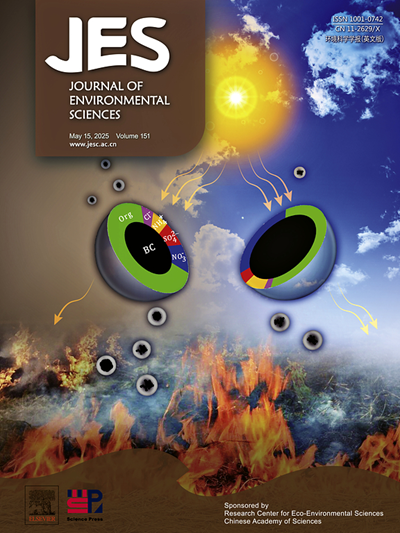Volatile fatty acids produced by waste activated sludge with low-dose nano-zero-valent iron synchronized with low-intensity ultrasonication pretreatment
IF 5.9
2区 环境科学与生态学
Q1 ENVIRONMENTAL SCIENCES
引用次数: 0
Abstract
Recently, using anaerobic hydrolysis of waste activated sludge (WAS) to recover volatile fatty acids (VFAs) as carbon sources for denitrification has been widely studied, and the key is to solve the problem of improving the solubility and bioavailability of WAS organic matter. Considering the energy consumption and chemical cost, this paper used low-dose nano-zero-valent iron (NZVI) coupled with low-intensity ultrasonication (US) to pretreat WAS, and explored the effects of different treatment sequences on the fragmentation of WAS flocs particles, the dissolution of organic matter, and the subsequent biofermentation conversion process. The results showed low-dose NZVI synchronized with low-intensity US (NZVIUS) worked best for WAS anaerobic fermentation. Compared with 2062 mg/L in control group, soluble chemical oxygen demand (SCOD) after NZVIUS treatment reached up to 2786 mg/L during the fermentation cycle, and the initial release rate of SCOD increased by 69 %. The VFAs production was elevated from 1522 to 1940 mg COD/L. NZVIUS pretreatment promoted the solubilization of attached organic matter, manifested by the fragmentation of WAS flocs and cell lysis. At the same time, proteins and carbohydrates in the extracellular polymeric substances (EPS) had different types of migration and transformation, and transfer of EPS can contribute 35.6 % to SCOD. Moreover, adding NZVI promoted PO43−-P recovery in the fermentation supernatant by 22.3 % more than in day 4 control. This study demonstrated that the NZVIUS pretreatment method can effectively improve the production of VFAs by WAS anaerobic fermentation, meeting the practical needs of wastewater plants.

低剂量纳米零价铁同步低强度超声预处理废活性污泥产挥发性脂肪酸研究
近年来,利用废活性污泥(WAS)厌氧水解回收挥发性脂肪酸(VFAs)作为反硝化碳源得到了广泛的研究,其关键是要解决提高WAS有机物的溶解度和生物利用度的问题。考虑到能耗和化学成本,本文采用低剂量纳米零价铁(NZVI)联合低强度超声(US)预处理WAS,探讨不同处理顺序对WAS絮凝体颗粒破碎、有机物溶解及后续生物发酵转化过程的影响。结果表明,低剂量NZVI与低强度US同步(NZVIUS)对WAS厌氧发酵效果最好。与对照组的2062 mg/L相比,NZVIUS处理后发酵周期内可溶性化学需氧量(SCOD)达到2786 mg/L, SCOD初始释放率提高了69%。VFAs产量由1522 mg /L提高到1940 mg /L。NZVIUS预处理促进了附着有机物的增溶,表现为WAS絮凝体的破碎和细胞的裂解。同时,胞外聚合物质(EPS)中的蛋白质和碳水化合物发生了不同类型的迁移和转化,EPS的转移对SCOD的贡献率为35.6%。此外,添加NZVI后,发酵上清液中PO43−p的回收率比对照组提高了22.3%。本研究表明,NZVIUS预处理方法可以有效提高WAS厌氧发酵VFAs的产量,满足污水厂的实际需要。
本文章由计算机程序翻译,如有差异,请以英文原文为准。
求助全文
约1分钟内获得全文
求助全文
来源期刊

Journal of Environmental Sciences-china
环境科学-环境科学
CiteScore
13.70
自引率
0.00%
发文量
6354
审稿时长
2.6 months
期刊介绍:
The Journal of Environmental Sciences is an international journal started in 1989. The journal is devoted to publish original, peer-reviewed research papers on main aspects of environmental sciences, such as environmental chemistry, environmental biology, ecology, geosciences and environmental physics. Appropriate subjects include basic and applied research on atmospheric, terrestrial and aquatic environments, pollution control and abatement technology, conservation of natural resources, environmental health and toxicology. Announcements of international environmental science meetings and other recent information are also included.
 求助内容:
求助内容: 应助结果提醒方式:
应助结果提醒方式:


